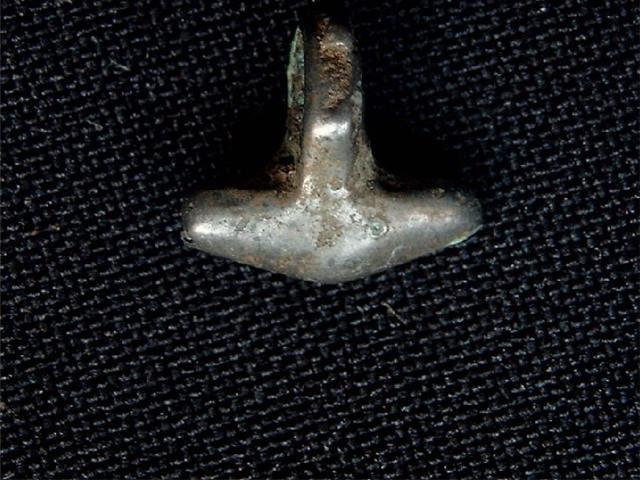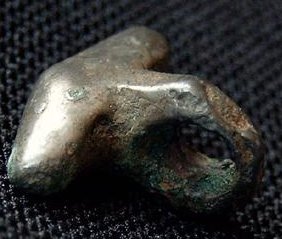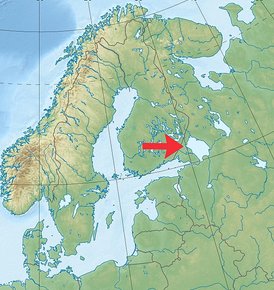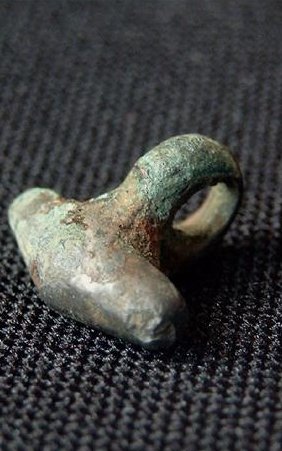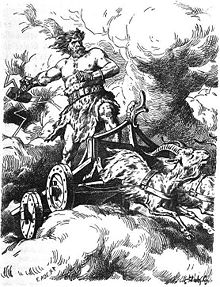A Thor's hammer pendant found near Lake Ladoga
A small silver Thor's hammer pendant cast in silver with a thick loop and rounded, stubby hammer shape.
10 mm width 11 mm length.. remarkably small.
Published in British Artefacts Volume 2 - Middle Saxon and Viking by Brett Hammond, p.58 Fig. 1.5.3-i.
The making of Mjolnir
An account of the creation of Mjölnir is found in Skáldskaparmál from Snorri's Edda: In this story, Loki bets his head with Sindri (or Eitri) and his brother Brokkr that they could never succeed in making items more beautiful than those of the Sons of Ivaldi (the dwarves who created other precious items for the gods: Odin's spear Gungnir, and Freyr's foldable boat Skíðblaðnir). Sindri and Brokkr accept Loki's bet and the two brothers begin working. They begin to work in their workshop and Eitri puts a pig's skin in the forge and tells his brother (Brokkr) never to stop working the bellows until he comes and takes out what he put in. Loki, in disguise as a fly, comes and bites Brokkr on the arm. Nevertheless, he continues to pump the bellows. Then, Sindri takes out Gullinbursti, Freyr's boar with shining bristles. Next, Sindri puts some gold in the forge and gives Brokkr the same order. Again, Loki, still in the guise of a fly comes and, again, bites Brokkr's neck twice as hard as he had bitten his arm. Just as before, Brokkr continues to work the bellows despite the pain. When Sindri returns, he takes out Draupnir, Odin's ring, which drops nine duplicates of itself every ninth night. Finally, Sindri puts some iron in the forge and tells Brokkr not to stop pumping the bellows. Loki comes a third time and this time bites Brokkr on the eyelid even harder. The bite is so deep that it draws blood. The blood runs into Brokkr's eyes and forces him stop working the bellows just long enough to wipe his eyes. This time, when Sindri returns, he takes Mjöllnir out of the forge. The handle is shorter than Sindri had planned and so the hammer can only be wielded with one hand. Despite the flaw in the handle, Sindri and Brokkr win the bet and go to take Loki's head. However, Loki worms his way out of the bet by pointing out that the dwarves would need to cut his neck to remove his head, but Loki's neck was not part of the deal. As a consolation prize Brokkr sews Loki's mouth shut to teach him a lesson.
The final product is then presented to Thor, and its properties are described, as follows,
"Then he gave the hammer to Thor, and said that Thor might smite as hard as he desired, whatsoever might be before him, and the hammer would not fail; and if he threw it at anything, it would never miss, and never fly so far as not to return to his hand; and if be desired, he might keep it in his sark, it was so small; but indeed it was a flaw in the hammer that the fore-haft was somewhat short."
Thor
The Norse god Thor is the son of Odin and Earth. His wife is Sif. He has one daugther, Thrudur and two sons, Modi and Mangi. His domain is called Thrudvang and his hall, Bilskirnir, is a huge place with 640 rooms.
Originally Thor was the Norse god of thunder. He is the strongest of all the Norse gods. His weapon is Miolnir, a hammer that is the finest piece among gods and men. He also has a belt which, when worn increases is strength. His third important piece is a pair of iron gloves that he can’t be without when he uses his hammer. When used together the three pieces doubled Thor’s strength.
The Norse god Thor protects the land of the gods from the giants. If he wasn’t around and with his hammer, the giants would over run Asgard (the land of the gods) as well as Midgard (the land of the humans) and bring total destruction. Thor is constantly battling the giants and kills so many of them that he’s able to hold them back. It is this role that made the Vikings view Thor as the Norse god of war.
Well. I could have been with these stones until after dark, but as my wife wanted to travel on.. well.. I see you again, some day, hogback stones from Gosforth. And if you happen to be there one day, do not forget that monument on the outside...
Further on with the Cumbrian hogbacktour !
In - yes, luckily again in - St. Peter's church in Heysham, there is a truly beautiful hogback stone. The guide told us, it had been studyied by Thor Ewing, a writer, in 2000. in 'Understanding the Heysham hogback' A tenth century sculpted stone monument and its context (link), Thor Ewing tells in detail what he dicovered on the both sides of this hogback stone.
Just being brought in the church as late as the 1970's accompanied with some protest here and there among the church visitors, considered as being a token of old paganism, it had been remarkably nice preserved, and a lot of detail can be seen, still. Truly worthwile a visit.
I had a small debate with the guide in the church if the - zoomorphic, in my opinion - faces on the sides were lions (or hippo's). The guide doubted if the vikings could have known about lions. Well I guess so, concerning the runes on the Ancient Greek lion statue at the Arsenal, Venice. For example. Vikings did travel south..
But when he told me he was doubting the vikings 'discovered' (as the native inhabitants were of course, in the first place) America before Columbus, I decided to rest my case..
One has to know when to start and to end a conversation ..
Just discovered the book in a bookstore written by Geoff Holder - The guide to the mysterious Lake District, I knew there had to be another hogback stone in Lowther, St. Micheal's Church. With a promising image described in the text of 'a naval and a land-based force of shield-bearing vikings above a fish and what might be a coiled sea serpent. On the reverse is a row of female figures with snakes, possibly a representation of the hideous hag Hel'. Wow. If that did not sound as a true pagan promised land ..
Not complaing too much after all we have seen, this visit was the dissapointing one of them all. But if you wife states 'I am happy to have seen them' and I am answering 'Measuring is knowing' and the even more obligate verb 'handling 'if we did not see it at all, we wouldn't have known anything at all of how they were looking' the glass was again half full, at the last day of our journey..
The hogback stone appeared to be just being tolerated within the entrance segment part of the church. As something you never use anymore but you do not throw away - entirely. That sort of feeling emerged when seeing this hogback asylum seekers.. Bed, bath and bread, ás we say in Dutch, but no luxury at all and standing on some outcuts of wood, you would balance the table with at home..
Come on, St. Micheal's Church.. care a bit more of your 'children' !
This hogback stone was moved in the church in 1907. Hogback stones layed partially buried in the churchyard before it was dug up and moved into the church.
The promising depiction of a longship - as certainly can be seen after some studying - see http://vikingminds.co.uk/pages/longship
we have missed !
The stone itself is (157 x 50 x 30 cm) and very worn.
The hogback stones in Cumbria - very diverse in quality, but everyone worth a visit ! Especially on a gloomy day in late October ...
The churches to visit - see photos of resp. St. Andrew's church in Penrith, St. Mary's church in Gosforth, St. Peter's church in Heysham and St. Micheal's church in Lowther.
Did I miss out on another one in Cumbria ? Let me know !
In a next blog I will take you to four - still remaining utterly mysterious- statues 'guarding' the graveyard of St. Andrew's church in Dacre..
For the last blog of October 9th see this link.
References: (as always, links to where the books can be ordered are attached).
Edwards, B.J.N. Vikings in North West England - The artifacts (1998);
Emery, Gordon, CURIOUS CUMBRIA, The Lake District & Beyond: A celebration of Cumbria (2023)
Ewing, T. 'Understanding the Heysham hogback' A tenth century sculpted stone monument and its context ;
Hall, R. Viking Age archaeology in Britain and Ireland (first printed 1990, reprinted with amendments in 1995);
Holder, G. The guide to the mysterious Lake District (2009)
possibly also (as there within the part of Cumbria dealing with Carlisle, the Eden Valley, Barrow-in-Furness, Whitehaven and the west coast is being dealed with)
Holder, G. Paranormal Cumbria (2010)
http://vikingminds.co.uk/pages/longship
